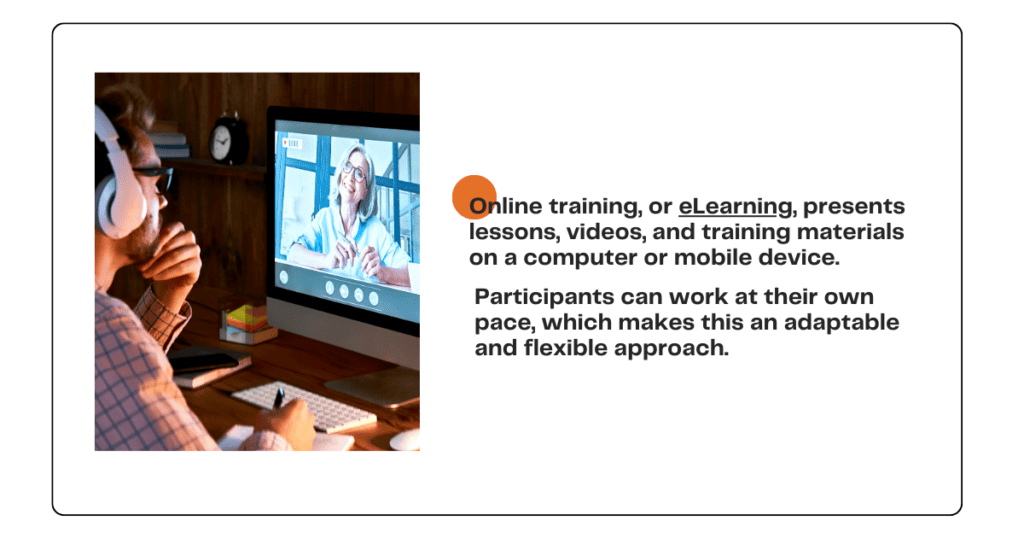Welcome back to our series on employee training for franchise business owners! We began this series by discussing the benefits of employee training, and then we looked at ten different types of training to suit different needs.
While choosing ‘types’ of training is about ‘what’ you will teach, this article narrows in on the ‘how’ you will teach it. In the article below, we will explore various training methods you can use to train your team.
8 Employee Training Methods
Training employees is not just about what you teach but how you teach it. Here, we will discuss eight popular employee training methods, share benefits and challenges, and offer tips on when to use each training method. Let’s dive in!
1. Instructor-Led Training
Instructor-led training is a conventional method where a professional trainer leads the session (either someone in your franchise who is qualified to teach or a hired instructor). Participants gather in a classroom-like setting, which allows for interaction and feedback. The trainer can adapt the material to suit individual needs, and the human element encourages questions and collaboration. Real-time discussions and personalized instructions make this method unique.
- Benefits: Instructor-led training often results in deeper understanding thanks to immediate feedback and interaction. The opportunity for face-to-face communication boosts engagement and allows the instructor to customize materials to the needs of the students.
- Challenges: This employee training method can be time-consuming if someone in your franchise must prepare and give the training. It may also be expensive if you need to hire a professional instructor.
- When to Use: Use instructor-led training when dealing with complex subjects that require hands-on guidance, when you need to teach theoretical concepts before employees can apply them in real life, or when a personalized human touch is essential for learning.
2. Online Training (eLearning)

Online training, or eLearning, presents lessons, videos, and training materials on a computer or mobile device. Participants can work at their own pace, which makes this an adaptable and flexible approach.
- Benefits: eLearning is cost-effective, scalable, and suitable for large audiences. It creates standardized training across locations and accommodates various learning styles and paces.
- Challenges: A lack of personal interaction may lead to lower engagement. Technical issues and varying levels of digital literacy among participants can also present challenges.
- When to Use: This training method is ideal for sharing standardized and consistent information across locations and when you need to track and analyze employees’ progress (as many online platforms have analytics).
3. Job Shadowing
Job shadowing involves observing experienced workers to learn specific skills or roles. Participants gain insights through direct observation in real-time and in the work environment. This training method offers a first-hand look at the daily responsibilities and activities related to a particular position.
- Benefits: Job shadowing provides experiential learning and insights into specific roles.
- Challenges: The success of job shadowing depends heavily on the individual being shadowed. It requires careful mentor selection and may lead to inconsistent experiences.
- When to Use: This training method is best for introducing new hires to roles, aiding in role transitions, or preparing for promotions by offering real-world experience.
4. Hands-On/On-the-Job Training

Hands-on training occurs on the job, where employees learn as they do the work. As employees practice their jobs, the skills and knowledge they acquire are immediately relevant and applicable to their work. As this method proves, sometimes the best way to learn is just to dive in.
- Benefits: Hands-on training encourages active participation and provides real-world experience. It helps employees understand and remember the procedures and responsibilities they’ll face daily, which leads to increased confidence and competence in their roles.
- Challenges: Implementing this training method requires proper planning, experienced supervision, and suitable resources. Mistakes made during training must be carefully managed to ensure they become learning opportunities for the trainee and don’t impact the customer experience.
- When to Use: Hands-on training is most effective when the tasks require physical practice or real-time problem-solving. It’s ideal for roles where observation or theoretical knowledge alone may not suffice.
5. Coaching
Coaching involves a one-on-one relationship between coach and employee where the goal is to work on individual development and performance. The coach (often a supervisor or manager) offers regular feedback and personalized guidance. The training method often includes goal setting and action plans to create a customized roadmap for success.
- Benefits: Coaching enables tailored support and individualized development. It often leads to accelerated improvement and can be aligned precisely with the individual’s needs and the franchise’s goals.
- Challenges: The success of coaching relies on the quality of the coach and may be time-intensive. It requires commitment from both parties and a clear understanding of goals and expectations.
- When to Use: Coaching is perfect for addressing individual performance issues, developing leadership, or supporting career progression with targeted personal guidance.

Technology can add a new dimension when coaching employees in customer-facing roles. Take Clarity Voice’s call coaching features. With listen-in, whisper, and join mode, supervisors can observe employee-customer interactions over the phone and provide immediate feedback. Integrating these tools into your coaching strategy can take your training program to the next level.
6. Mentoring/Peer-to-Peer Training
Mentoring involves experienced employees guiding their less experienced peers. This training method builds strong relationships and encourages collaboration through shared experiences, trust, and regular interaction.
- Benefits: Mentoring creates a supportive environment that often enhances job satisfaction and retention. It allows for personal growth and promotes a sense of community within the organization.
- Challenges: Matching mentors and mentees requires careful consideration, and success depends on the compatibility and commitment of both parties.
- When to Use: Mentoring is ideal for onboarding new employees or assisting in career progression and personal growth.
7. Role-Playing

Role-playing involves acting out scenarios to practice reactions, decision-making, and empathy. Participants explore different perspectives and complex interpersonal dynamics.
- Benefits: Role-playing is hands-on practice for adapting to different situations employees may encounter on the job. It helps build skills like empathy and conflict resolution.
- Challenges: Role-playing needs proper planning and someone who can lead it well. Without that, some might find it awkward or even unhelpful.
- When to Use: Use role-playing for customer service training, sales tactics, or any other area that needs practice in interpersonal relationships and making quick decisions.
8. Case Studies
Case studies use real-life scenarios to build critical thinking, problem-solving, and decision-making skills. Participants analyze situations, reflect on solutions, and discuss different approaches. It’s a training method that connects theoretical concepts with practical applications.
- Benefits: Case studies bridge theory and practice, enhancing understanding through relevant, real-world examples.
- Challenges: Creating effective case studies requires time and expertise. The success of this training method depends on participant engagement and the relevance of the scenarios.
- When to Use: Case studies are ideal for training employees whose roles and responsibilities require an understanding of complex real-world scenarios and who can benefit from seeing how real scenarios have played out in the past.

One practical way to employ case studies in your training program is through Clarity Voice’s call recording feature. This feature of FranchisePhones® enables you to preserve instances of exceptional customer service over the phone and use them as case studies for new hires. By listening to the recordings, new team members can gain insight into how experienced colleagues handle phone communication, from routine calls to tricky situations.
Choosing the Best Employee Training Methods
We’ve covered a lot of ground today! From eLearning to role-playing, there are many options for training your franchise team. Finding the right mix of employee training methods might seem like a puzzle, but it’s one that’s worth solving.
Remember, it’s all about fitting the training methods to your needs and goals. What resonates with one team member might not connect with another, so flexibility is key. If you’ve enjoyed exploring training methods with us, watch for our next article, where we’ll guide you through building an employee training program tailored to your franchise. It will be practical, actionable, and hopefully, a little fun too. See you there!



